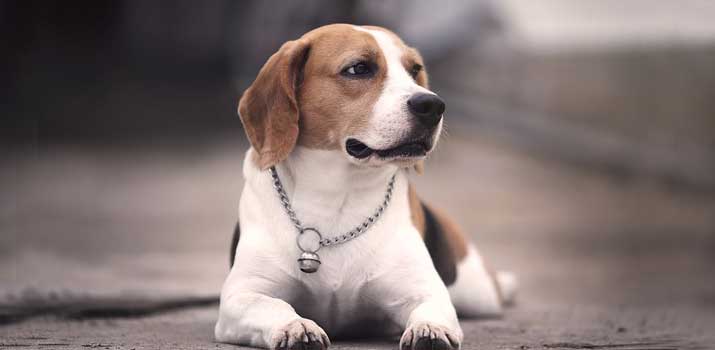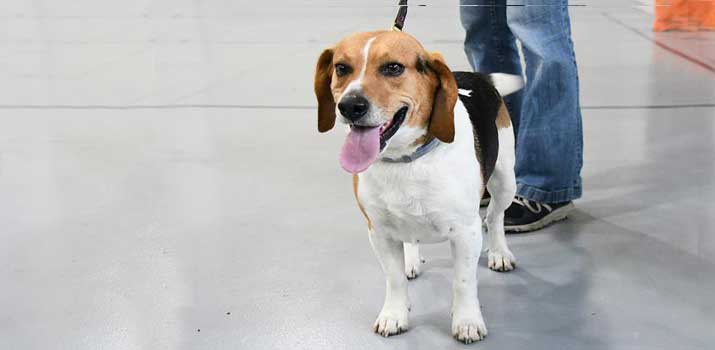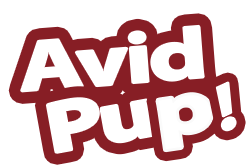
Beagles are adorable little dogs with a history steeped in tradition. One look at those floppy ears and most people can’t help but fall in love!
These dogs are naturally merry, fiercely loyal, and surprisingly helpful in hunting environments.
They’re considered small to medium-sized scent hounds. Think of them as the pint-sized Bloodhound.:)
However, it doesn’t take long until that clumsy pooch becomes an eager adult ready to accompany you on any adventure.
Understanding the Beagle growth process is a must.
These dogs aren’t as well-known as more popular breeds. As a result, new owners tend to go into raising a Beagle blind We always recommend following a growth chart.
Growth charts can give you insight into your pup’s development.
It can give you peace of mind that your pup is on a healthy track to adulthood. It can be your guide in feeding and exercise, too.
All the while, you can track your dog’s progress and address issues if you suspect that your Beagle isn’t developing correctly.
Whether this is your first time owning a Beagle or you’re a seasoned hunter with a history of Beagle companions, check out the growth chart below to stay on top of your dog’s development.
Beagle Growth Chart
Beagles go through numerous life stages. You can refer to the growth chart to get a more specific guideline of what to expect.
Most Beagle growth charts begin at around eight weeks old, allowing you to find the appropriate weight bracket and follow your pup’s development.
However, understanding the primary life stages is essential, too.
It can give you a head’s up of what to expect and let you know how big your Beagle should be at any given point.
| Age | lbs | lbs | lbs | lbs | lbs |
|---|---|---|---|---|---|
| 8 Weeks | 4 | 4.5 | 5 | 5.5 | 6 |
| 9 Weeks | 4.5 | 5.1 | 5.6 | 6.2 | 6.8 |
| 10 Weeks | 5 | 5.6 | 6.3 | 6.9 | 7.5 |
| 11 Weeks | 5.5 | 6.2 | 6.9 | 7.6 | 8.3 |
| 3 Months | 6 | 6.8 | 7.5 | 8.3 | 9 |
| 4 Months | 8 | 9 | 10 | 11 | 12 |
| 5 Months | 11 | 12.4 | 13.8 | 15.1 | 16.5 |
| 6 Months | 13 | 14.6 | 16.3 | 17.9 | 19.5 |
| 7 Months | 15 | 16.9 | 18.8 | 20.6 | 22.5 |
| 8 Months | 17.5 | 19.7 | 21.9 | 24.1 | 26.3 |
| 9 Months | 19.5 | 21.9 | 24.4 | 26.8 | 29.3 |
| 10 Months | 21.5 | 24.2 | 26.9 | 29.6 | 32.3 |
| 11 Months | 24 | 27 | 30 | 33 | 36 |
| Full Grown | 26 | 29.3 | 32.5 | 35.8 | 39 |

Beagle Pregnancy and Gestation
First things first, let’s touch on pregnancy.
How long does it take for Beagles to gestate?
On average, it takes between 58 and 68 days. That’s not very long at all, and most pups are ready to go by day 63!
After they emerge from their mother’s womb, puppies officially start their journey to adulthood, starting at the first stage of the growth chart.
From Birth to Two Weeks Old
At birth, most Beagles weigh only a pound. Newborn puppies are pretty helpless at this point.
The eyes are still closed, and most puppies can do nothing but wriggle around.
Their mothers do a lot to take care of them immediately after birth. They’ll feed on her teet to grow. You’ll notice significant growth in the first couple of weeks.
Pups get stronger and usually shart crawling around by the end of the second week.
Three Weeks
Your pup’s eyes and ears should be open by the third week. They will be more aware of their surroundings and have more strength to explore independently.
Most won’t be walking or running yet. However, puppies may start interacting with littermates and playing.
Four to Six Weeks
Here’s where a dog’s personality starts to come out. You’ll see that signature puppy playfulness come out.
Most canines get close to their littermates and have fun. You’ll see them running around, whining, and even biting one another!
Don’t worry: it’s all innocent. At this stage, most pups will start to wean off their mother’s milk and move to dry kibble.
Seven to Eight Weeks
You’ll notice your dog eating more during this stage. Puppies flourish, and you must look at the growth chart to ensure they’re on the right track.
Socialization is vital, and many pups start to learn between right and wrong from their mother. It’s also when you should bring your pup to the vet for the first time.
12 Weeks
By the 12-week point, your puppy will be significantly bigger than they were a few weeks ago!
Many canines experience a rapid growth spurt, reaching weights of six to nine pounds. High-quality food is a must. The same goes for exercise.
12 weeks is around the time when you should begin house and behavioral training.
Six Months
Most Beagles are roughly 10 to 12 pounds at around six months old. This life stage is considered the halfway point for growth.
There’s still room to grow. But despite their small size, many dogs become sexually mature at this age.
If you’re thinking about spaying or neutering, now is the time to talk to your vet.
Nine Months
You’ll see slow and steady growth in the months leading up to nine months old.
Beagles can develop insatiable appetites during this stage, so plan out meals and avoid overfeeding. Sticking to a healthy exercise routine is paramount, too.
One Year
Congratulations! Your dog is officially considered an adult once they reach 12 months old!
The months leading up to your dog’s one-year birthday may bring about a growth spurt. Make no mistake: Your dog still has room to grow. But, you could consider switching to adult dog food.
Consult with your vet before doing so. Your dog isn’t done growing, so they may still need the nutrition of puppy formula.
It all depends on where your dog is at in the growth cycle.
18 Months
At a year and a half, Beagles usually reach their full adult size. Your dog is officially full-grown!
That doesn’t mean you can stop worrying about diet and exercise. Your furry friend can still pack on the pounds.
Maintain a healthy lifestyle to keep your hound healthy for years to come.
Average Adult Beagle Size and Weight
So, how big do Beagles get?
The average adult Beagle stands tall at 13 to 16 inches.
Males are usually on the upper end of that spectrum, while females are generally 13 to 15 inches tall.
As for weight, you’re looking at 18 to 24 pounds.
Once again, males are usually bigger, tipping the scales at 22 to 24 pounds. Those are the averages you can expect. However, outliers do exist.
There’s no way to guarantee how big your dog will get. That’s why growth charts are so vital.
Pocket-sized Beagles exist, too. These dogs are rarer, and they have unique growth cycles.
We will not focus on these small dogs in this guide, and the growth chart doesn’t reflect their development.
Generally, adult Pocket Beagles get as tall as 12 inches and weigh up to 15 pounds at most.
Ways to Predict Adult Size
Beagles are a long-established breed. As a result, we know a lot about how these animals grow and develop.
Again, there are no ways to guess how big an animal will get definitively. But, you can use existing knowledge of Beagle development to get a general idea.
You have to wait until your puppy gets to about 14 weeks of age to predict weight.
Then, you can multiply that figure by 2.5 to get a rough estimate of their adult size. The formula is
(Weight at 14 weeks) x 2.5 = estimated adult weight
Predicting your pup’s height is a little trickier. You’ll need to wait until about six months of age and measure your dog’s height at the withers.
With this figure, you can use this formula to estimate height:
(Height at six months) x (100/75) = estimated adult height
Take your findings with a grain of salt.
Breeders use those formulas as a rough estimate. There are far too many factors that affect growth, and things could change depending on how you raise your dog.
Look at your Beagle’s paws if you want to keep things simple and ditch the number!
Generally, more giant feet indicate that your pup will fall on the upper end of the size and weight spectrum.
What Affects Beagle Development?
Beagles are living, breathing animals. Like human babies, a lot can happen in a puppy’s journey to adulthood!
Every little thing counts, and many factors will impact how your young furry friend will grow.
The entire point of using a growth chart is to better understand how they develop.
If your dog isn’t following the chart, you can assume that there’s an issue with one of the following factors.
As always, take your dog to a vet before making any sudden changes, and don’t be afraid to ask for their guidance if you’re having trouble getting things right.
Let’s take a look at what will influence how your dog grows.
Diet and Nutrition
What your pup eats has a significant impact on their development.
Walk through any dog food store, and you’re bound to see aisles of puppy food. You may even see some breed-specific options that cater to Beagles exclusively.
Not every dog food you see will meet your Beagle’s dietary needs.
As an owner, it’s your responsibility to choose some nutritionally fulfilling chow, delicious enough to appeal to hungry pups, and chock-full of ingredients that support continued development.
Do your homework here and ensure that you’re providing a protein-rich product with the right amount of calcium and phosphorus.
Also, pay attention to portions. Feeding too little will stunt your dog’s growth. But feeding too much can lead to obesity and other health problems.
Related: 10 Health Improving Food Boosters You Can Add to Your Dog’s Regular Meal.
Genetic Predisposition
Genetics always comes into play. Some dogs are predisposed to be bigger or smaller. It all depends on their lineage.
The best way to understand how genetics will affect your dog is to learn more about the mother and father. That shouldn’t be an issue if you went to a reputable breeder.
Most breeders keep pedigree information readily available.
If you adopted your dog, understanding lineage could be tricky. However, modern DNA tests make genetic profiling much easier.
Exercise and Physical Activity
Beagles aren’t the most hyperactive dog you’ll encounter. But, they still require plenty of exercise time.
Younger Beagles are naturally curious and full of life. Harness that energy and encourage your dog to stay active.
Stick to a routine, and your dog will develop strong muscles. Regular exercise is critical for overall health.
That said, you don’t want to overdo it! Too much exercise could lead to bone and joint problems, so find a good balance.
Spaying and Neutering
These procedures remove reproductive organs. Vets usually recommend getting it done between four and nine months of age.
These procedures can do wonders to keep dogs healthy and happy.
It prevents unwanted pregnancy to help control the pet population, reduces the risk of ovarian or testicular cancer, and even reduces aggression.
However, when it’s done too early, spaying and neutering can slightly stunt a dog’s growth.
When done before the growth plates close, it can prevent dogs from getting larger and taller.
Consult your vet to determine the best time for spaying or neutering your pup.
Related: How Soon Can I Take My Dog for a Walk After Neutering?
A Little History On the Beagle Breed
Beagles have a unique history. Like many other popular hunting breeds, these pups are most commonly associated with Great Britain. However, the exact origins remain a mystery!
Many hound breeds arrived in Britain sometime around the 11th century. However, the term “Beagle” already existed. It was primarily used as a catch-all moniker that referred to any small-sized hound dog.
For this reason, it’s hard for historians to trace the dog’s roots.
We do know that crossbreeding was huge during this period. Many miniature Beagle breeds appeared. One notable example is the Glove Beagle, which was small enough to fit onto a glove.
It wasn’t until the 1830s that the breed we know today emerged.
Once again, the details are hazy. However, it’s believed that a reverend in Essex is responsible for creating the earliest variant of the modern Beagle.
The exact lineage of those first litters is unknown, but North Country Beagles and Southern Hounds are likely represented.
Those first liters were slightly smaller. However, further crossbreeding resulted in a more standardized Beagle type in the 1840s. It was around that time that these dogs came to the United States.
Beagles continued to be popular in the next century. By the 1950s, they were one of America’s most prevalent dog breeds.
From 1953 to 1959, it was the number-one registered breed with the American Kennel Club. While these lovable dogs aren’t as popular as they once were, they still appear in the AKG’s top-ten list.
Modern Beagles are pretty easy to identify. While different colors exist, the most common is a tricolor mix of white, tan, and black.
Most of the lower body and snout are usually all white. Meanwhile, large patches of tan and black adorn the back for a signature look you can’t miss.
Don’t forget about the ears! The most defining feature of these dogs is their large, floppy ears that hand well below their heads.
Conclusion
Watching your Beagle grow up before your eyes is nothing short of inspirational.
These dogs are a joy to raise, and watching them go from curious puppies to loyal adults is rewarding.
Use a growth chart to monitor your pup’s development. While every canine is different, you can use the chart and known growth stages to ensure that your canine companion is healthy.
Also Read: Why are Beagles used in Lab Testing and Experiments?

